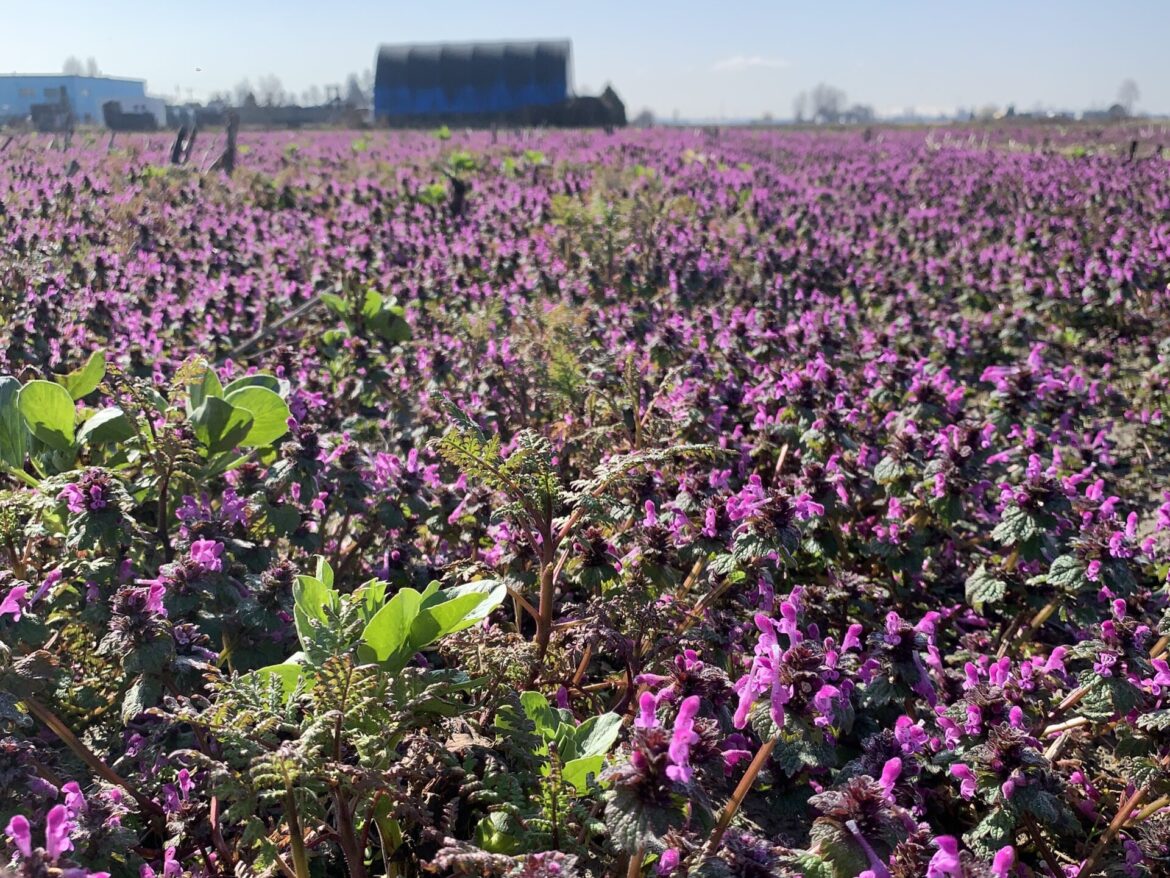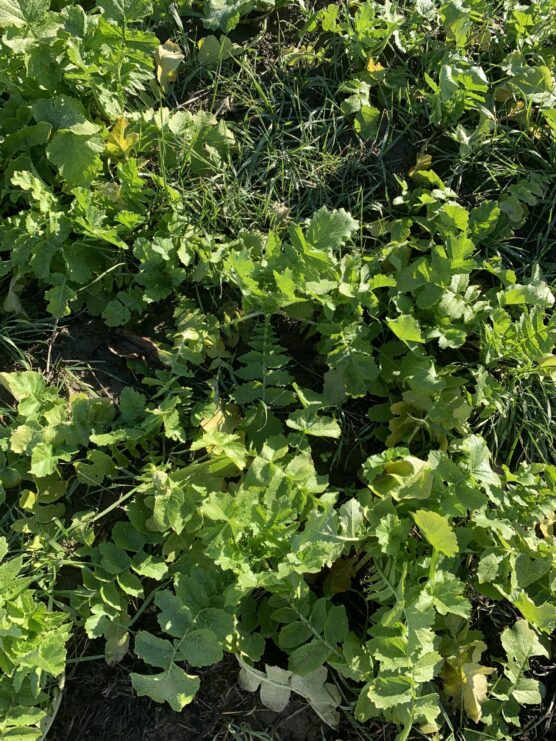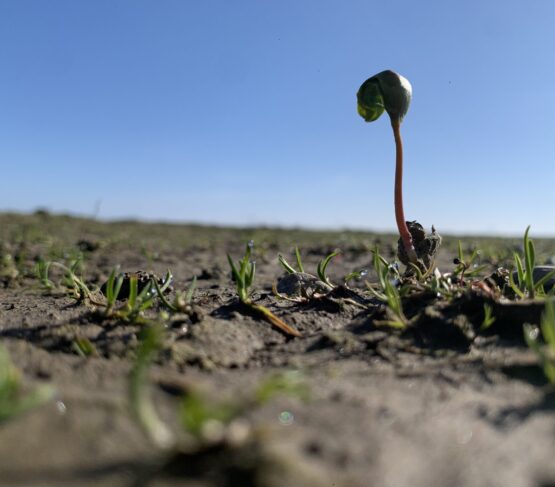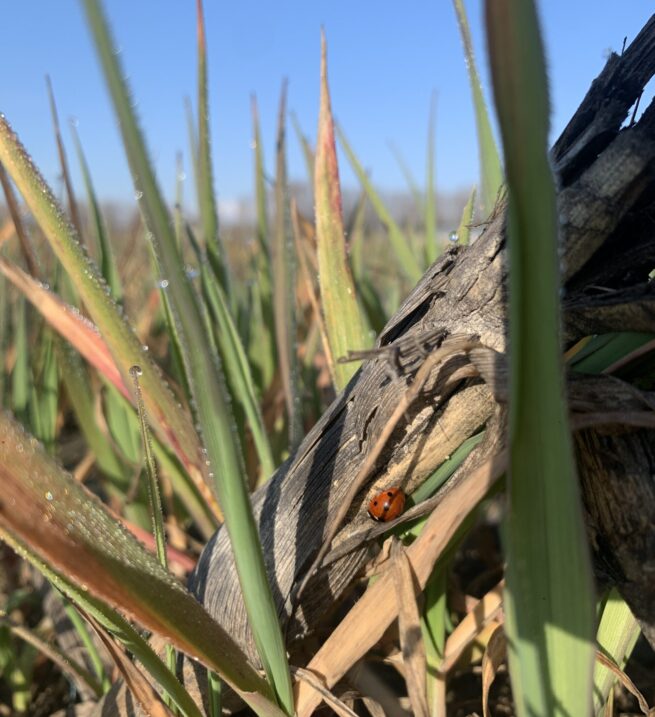
Image 1: A blooming pollinator mix cover crop found in Delta
Planting Cover Crops to Enhance Soil
Resilient soil can help to alleviate challenges when it comes to planting dates and crop yields, as well as helping to lower the costs of fertilizer, nitrogen, and irrigation. Cover crops are an essential tool, and when paired with regenerative management practices, operations can see improvements in their soil.
Though cover crops are an additional expense, even after one year, they can provide both economic and soil health benefits, which increase with each year planted.

Image 2: A pollinator mix cover crop providing organic soil cover
Erosion
Topsoil erosion can decrease long-term
agricultural productivity. Fallow fields are susceptible to erosion through
wind or rain, especially during winter months when the weather is more severe. A single falling raindrop that hits bare soil can dislodge and loosen soil particles and make them more likely to be washed away [1]. Cover crops protect the soil with organic residue during winter when soils have no other cover [2]. Plant material will decrease the impact of falling raindrops, acting as a physical stabilizer for topsoil, with roots providing a pathway for surface water to move into the soil, rather than across [2].
Cereal rye is useful in erosion protection throughout colder areas of North America, as it germinates and grows quickly in cool weather and has a fibrous root system with a large capacity to provide soil cover [2].
The Universal Soil Loss Equation predicts that having just 10% of organic cover over the soil will correlate to a 30% reduction in erosion rates, while 50% cover will result in 80% or greater reduction in erosion rates [2].
Soil Structure and Aggregation
In the spring, a cover crop will decompose and incorporate plant residue into the soil, increasing organic matter and soil aggregation. When organic matter is left in the soil to be broken down by micro-organisms, it produces compounds such as polysaccharides, which help glue soil particles together [1]. These compounds help soil particles bind into larger aggregates which improves aeration, water infiltration and holding capacity, it also helps the soil be less prone to compaction [3]. Soil compaction can lead to decreased yields of field vegetables by up to 50% [1].
Grasses with a fibrous root system can also help in the formation of soil aggregates. These roots will spread through the soil and release a compound which aids in the binding of soil particles [1]. These improvements help soil productivity and improve spring crop performance [3].
Carbon
Climate change has been a prominent issue for farmers over the past several years. With extreme weather events happening more frequently, such as flooding, extreme heat during the summer, and extended periods of wet weather during the spring, it is important to factor climate change into farm management decisions.

Image 3: A seedling found in a winter cover crop
With a long history of land use change, biological materials are often removed from farm soil through harvesting or land preparation. Plant residue left from crops is the main source of carbon in agricultural soil [4]. Living plants are also able to store carbon in the soil through photosynthesis. This means farm soils have a larger potential to store carbon through management practices such as cover cropping. Winter cover crops help store carbon throughout winter, and plant matter is then left in the field as green manure [5]. The increase in soil organic matter from the cover crop is then able to reduce the agricultural emissions of greenhouse gases by sequestering atmospheric carbon and storing it in the soil.
Accumulation of soil organic carbon may be a slow process, but the long term health of the soil will help keep crops growing in the fields. Plots planted with cover crops have been observed to have 26% to 36% greater carbon in the soil compared to plots without cover crops, with some reports noting up to a 400% increase in carbon in long term studies [6]. Soil carbon can be used as a source of nutrients in the soil, it also helps soil aggregation, increases microbial activity, and increases the availability of water for plant use.
Nitrogen
Certain plants used as cover crops, such as legumes, can convert nitrogen in the atmosphere into usable soil nitrogen for plants [1]. The long, fibrous tap root of legumes can also establish a deep and extensive root system to catch nutrients after a summer crop [1]. Legume cover crops can provide 40 to 200 lbs./ac of available nitrogen for crop production [3].
Incorporating cover crop residue into soil also increases available nitrogen for following crops, which can uptake 30% to 60% of the nitrogen produced by the cover crop [1]. For example, a no-till corn system following a hairy vetch cover crop can be maintained with 20% less applied nitrogen [3].
Nutrients
Cover cropping can help prevent the loss of nutrients from the soil ecosystem [2]. After harvesting summer crops, many soil nutrients can become inaccessible and lost in deeper layers of the soil. By planting a cover crop, such as rye, the roots of these plants scavenge for soil nutrients which have leached into deeper parts of the root zone. These crops can help accumulate nutrients such as nitrogen, phosphorus, potassium, calcium, magnesium, and sulfur, in the upper layers of soil [7].
The scavenged nutrients will remain and break down in the soil following cover crop termination and become available for uptake by spring crops [3]. When a cover crop is incorporated into the soil as a green manure soil microorganisms will multiply to help break down the plant material [7]. The breakdown of plant material will release nutrients which were held in the plant tissue into the soil [7].
Table 1 below demonstrates the amount of nutrients which were found to be in the canopy of a cover crop.
The dry weight of above ground plant material is shown as biomass, and the amount of nutrients contained in the canopy is described in pounds per acre [8]. When these cover crops are used as green manure, these nutrients become available in the soil for the following crops, and thus fertilizer applications can be reduced [8].

Image 4: A densely grown cover crop which smothers any weed growth
Weed Control
Cover crops compete with weeds for nutrients, sunlight, and water, which restricts and prevents the growth of weeds. Crops with a high biomass such as rye are especially good at capturing these growth requirements and smothering weeds. Cover crops are able to inhibit weeds at multiple stages of growth from propagule production and seedling establishment, to minimizing the ability of individual weeds to outcompete surrounding crops [2].
Winter cover crops reduced annual weeds by 41% to 81% when compared to systems without cover crops [6]. Cover crops can possibly allow producers to forgo one to two herbicide treatments in the following crop [3].
Insect and Disease Control
There are preliminary studies showing cover crops can produce chemical factors which directly impact pathogens and help prevent disease in crops [1]. Adding beneficial microbes into the soil to discourage disease and encourage beneficial species of nematodes is a secondary pest related attribute [1]. Cover crops are also used to attract beneficial insects to fields, which feed on pests [2].

Image 5: A ladybug seen in a winter cover crop field
Cover crops promote predatory insects, which help eliminate other undesirable pests. In conventional agriculture, pesticides and chemical treatments used to kill pests also kill beneficial insects [1]. When including cover crops in rotations, beneficial insects will often be found in fields when prepared with appropriate spring crops, because this management system will provide food and habitat for beneficials year-round [1]. For example, using a legume cover crop can help inhibit aphids in broccoli crops [2].
Cover Crop Variety
Traditional cropping systems grow one crop within a field each year. Microorganisms that live within the soil require a variety of nutrients to generate robust healthy soils. Using a cover crop mix can help to feed soil organisms with the variety of nutrients they require while also providing other key features [9]. Complex mixes are recognized as an important way to increase the health of microorganisms within annually cropped landscapes [9].
Each species of cover crop can work to enhance a select feature of the soil system. To maximize soil health, a variety of cover crop species can be used to gain complementary benefits from each species. Single species cover crops such as oats, cereal rye, and clover, for example, provide advantages when planted on their own. Oats and rye are often viewed as a more economic seed choice, with lower costs and high availability compared to other seeds and are able to produce large amounts of above ground biomass [10]. While crops such as clover work well to fix additional nitrogen into the soil as well as
producing a high-quality biomass [10]. On their own these crops may seem like an ideal choice for a winter cover crop but planting a single species has disadvantages as well. Oat and rye crops do not fix nitrogen, thus when grown without supplemental nitrogen they can produce low biomass [10]. Clover can fix nitrogen in the soil but produces a nonuniform cover [10]. Though single species cover crops may provide benefits, plating a complimentary mix of cover crops will provide the best overall value.

Image 6: An oat and vetch cover crop mix
The ideal selection of cover crops will vary depending on
the desired outcomes for each grower. When picking an ideal cover crop mix it is important to consider how species growth periods, forms, and nitrogen
requirements will complement each other [11].
For example, a mixture of oats, clover, and annual ryegrass have a complimentary growing period, where the oats will establish in the fall to help suppress weeds and scavenge nitrogen but will not endure prolonged freezing temperatures. The clover and ryegrass in this mix are moderate winter-hardy crops, and will be able to continue growing in the springtime, which provides additional nitrogen fixation and soil cover until termination [11]. This type of complementary mixture ensures soil cover throughout winter, providing soil protection from erosion, as well as resources and habitat for beneficial insects.
If operators are experiencing high amounts of soil pests, which are limiting crop yield, a legume-brassica cover crop may be a viable management strategy. Legumes, such as clover or hairy vetch will work to help fix nitrogen in the soil, as well as help enhance beneficial organisms [10]. Pairing this crop with a brassica such as radish will attract pollinators to the field as well as suppress detrimental nematodes and soil borne diseases which will improve soil health for following crops [10].
Planting a variety of cover crop species with a diversity in ecosystem functions can provide multiple benefits to farm fields throughout the winter season, and by considering soil characteristics operators can make better decisions when picking cover crop varieties and seeding rates [12].

Image 7: Cover crop mixture with complimentary forms of growth
There are many suitable cover crops to help operators achieve desired outcomes within their unique management systems. Regenerative management strategies, such as planting effective cover crops, can generate resilient soils and provide natural solutions to issues such as pests, soil nutrient depletion, and weed control. Delta Farmland and Wildlife Trust shares the cost of planting cover crops with farmers through the Winter Cover Crop cost-share program, to help alleviate the stress of adopting this management
system.


References
[1] Managing Cover Crops Profitably, Sustainable Agriculture Research and Education, 2012.
[2] M. Sarrantonio and E. Gallandt, "The Role of Cover Crops in North American Cropping Systems," Journal of crop production, pp. 53-74, 2003.
[3] J. . S. Bergtold, S. Ramsey, L. Maddy and J. R. Williams, "A review of economic considerations for cover crops as a conservation practice," Renewable Agriculture and Food Systems, pp. 1-15, 2017.
[4] M. K. Jarecki and R. Lal, "Crop Management for Carbon Sequestration," Critical Reviews in Plant Science, pp. 471-502, 2003.
[5] C. Poeplau and D. Axel, "Carbon sequestration in agricultural soils via cultivation of cover," Agriculture, Ecosystems and Environment , pp. 33-41, 2015.
[6] S. I. Haruna, S. H. Anderson, R. P. Udawatta, C. J. Gantzer, N. C. Phillips, S. Cui and Y. Gao, "Improving soil physical properties through the use of cover crops: A review," Agrosystems, Geosciences & Environment , 2020.
[7] P. Sullivan, "Overview of Cover Crops and Green Manure," Appropriate Technology Transfer for Rural Areas, 2003.
[8] G. D. Hoyt, "Legumes as a green manure in conservation tillage," 1990.
[9] G. Brown, Dirt to soil: one family's journey into regenerative agriculture, White River Junction: Chelsea Green Publishing, 2018.
[10] T. Chapagain, E. A. Lee and M. N. Raizada, "The potential of multi-species mixtures to diversify cover crop benefits," Sustainability, 2020.
[11] C. White and M. Barbercheck, "Making the most of mixtures: Considerations for winter cover Crops," 19 September 2017. [Online]. Available: https://extension.psu.edu/making-the-most-of-mixtures-considerations-for-winter-cover-crops.
[12] J. Blesh, "Functional traits in cover crop mixtures: Biological nitrogen fixation and multifunctionality," Journal of Applied Ecology, pp. 38-48, 2017.
